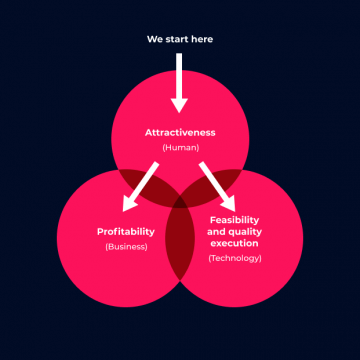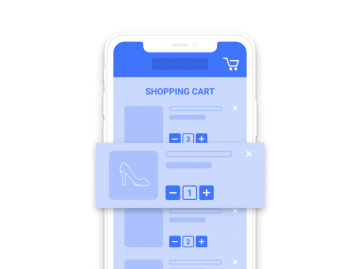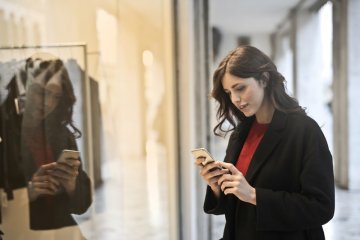Currently, there is a new interesting trend in m-commerce. Shopping applications have become ubiquitous and whether a store owns an app or not is no longer the issue. What is the question is, however, how this app supports customers in making a purchase. The emphasis no longer rests on attracting customers, although this is still a key issue, but rather on offering them a unique shopping experience with the use of applications. Within the mobile domain, there function a number of solutions which ought to be taken into consideration by any retail player.
Statista experts forecast that m-commerce with the use of mobile devices will amount to 44.7% of total e-commerce in the USA by 2019, in contrast to 39.6 % in 2018. It shows that consumers on the American market, which serves as a global reference point, are increasingly choosing mobile devices to buy online.
The previous Black Friday, an internationally recognised special discount and record sales day, testifies to this tendency. Analysts at Adobe estimated that over one third of transaction on that day were conducted via a mobile device. In 2017 this metric stood at 29.1%.
This tendency for customers to shift towards m-commerce forces retailers who operate online to take a few crucial factors into account. To start, let us point out that customers use both online browsers and applications, and each channel may cater to different needs.
Customers who use browsers on a mobile device:
- Search for products that are a natural fit. They research the product and make use of rankings and suggestions. Customers may not know the exact make and model for their desired earphones, but just by keying in the phrase ‘best earphones’ they will easily find helpful listings, which will impact their choice.
- Rely on comments and opinions by other users, which is why many stores and independent online platforms offer a possibility to rate products by means of points or stars and to publish comments.
- Look into ratings and opinions not only on a given product but also on a given store, thus an average rating in Google comprises a significant element of company image. Customers enquire about service and products on offer, as well as the location of the store and its contact details.
Generally, it seems a browser is used mainly as a source of information as far as online shopping is considered. Mobile apps, in turn, take the customer one step closer towards the actual purchase, although, they perform an informative function, too.
Customers who use store application on a mobile device:
- Check for discounts and latest offers. In case of app-only coupons customers have no way of learning about a discount unless they have installed an application. By default an app itself makes product browsing easier with the use of filtering options, e.g. by latest collection or on-sale items only.
- Hope for personalised recommendations. Applications store user data and as a result customers may receive tailor-made offers.
- Make use of wishlists to browse through products they find interesting and compare them, e.g. a few pairs of shoes or similar electronic devices.
Internet browsers and mobile apps are mutually complementary in the purchase process, although, transactions are closed mostly via applications. A last year survey by Scandit Retail Consumer shows that 83% of smartphone shoppers use a shopping application.
What to Include in Shopping Apps? Must Have Functionalities for Modern M-Commerce Applications
More and more retailers know that mobile apps help attract customers. Our article published last year on shopping applications stated that shopping applications have become a standard solution in e-commerce, rather than an attractive add-on. As the leading brands have been developing their mobile stores for years, applications and mobile web pages alike, minor players also have to learn to invest in m-commerce solutions not to get left behind.
Here are a few example solutions that have become an m-commerce standard.
- Easy search options. These denote an expansion on the popular search button. A simple keyword search is not enough. Google popularised voice search has spread onto e-commerce, too, and each modern app should allow such an option. Needles to say it should also provide filtering to narrow down the search range.
- Push notifications and in-app messages. This solution significantly drives user engagement as it guides users through every step of the procurement process, provides useful information or sends reminders on products still left in the shopping cart. These all constitute elements of a modern communication strategy, which influences sales directly.
- Loyalty module. Every company strives to inspire ever more loyalty among its existing customers. This, however, requires effort as loyalty is a bond forged mostly by sellers. A mobile app ought to support this aim by means of in-app loyalty cards or benefits earned through point programs, such as coupons, discounts or prizes, as well as with the use of personalised offers.
The solutions we talked about are categorised as must-haves, i.e. factors, which represent intrinsic elements of every state-of-the-art shopping application. Even so, on the market there are other modern above par solutions used by the world’s key players in e-commerce.
Although today few customers expect them as core functions – they are what might be termed nice-to-have features – it seems likely that more and more stores will keep on investing into similar solutions. Here follow a few examples to inspire you.
Augmented Reality and M-Commerce
Unlike Virtual Reality, Augmented Reality is a solution that requires no additional equipment such as special goggles. With the use of AR technology, IKEA has enabled its customers to place simulated furnishings into their spaces. While choosing an armchair, a desk or a bookcase, customers are able to actually see what a given piece of furniture would look like in their own apartment or office. App users can freely move about the space and see the furnishings at every angle. Both parties benefit. As customers are able to check how furnishings fit spatially, the percentage of returns due to mismatched size or style has been decreasing. Buyers need not fear that the furniture they had transported and assembled will have to be dismantled, repacked and taken back to the store, whereas IKEA gains in customer satisfaction and a smaller number of returns. Additionally, having implemented the solution, IKEA received extensive coverage in the media and was recognised as one of the 50 most innovative companies by Fast Company.
Sephora also uses AR technology. The company has solved two important problems by letting users try on virtual make-up products. First, buying beauty products online women have to either choose a brand they are already familiar with or experiment in hope that the new colour scheme will make them look and feel just as well. Unfortunately, often the choice proves disappointing and the products clutter bathroom shelves. Second, to choose the right beauty product, women have to visit a store where a number of testers are available. Still, many women find it uncomfortable to test make-up in public and in a hurry, let alone the incessant need to put on and remove the various products. With the help of Sephora app, which uses facial recognition, women may try on different looks, playing with lip colours or eyeshadow. As pointed out in our e-book, Mobile Apps in Retail Sector (available in Polish at: https://appchance.com/pl/mobileretail), as regards brands the importance of accessible analytical data on customer preferences, which could effectively translate to customisable offers, discounts and communication, cannot be stressed enough. Furthermore, the use of AR to solve such a practical problem entices users to visit the app more often, which in turn results in higher sales, increased brand exposure and multiple communication opportunities.
Shop Assistants, Visual Search and User Location
There is much talk on chat bots replacing phone consultants, which is changing the face of customer service as we know it. The trend has reached m-commerce, too. For instance consider Enki, a virtual assistant crafted for ASOS store. Using image recognition it can suggest clothes similar to those in user’s pictures. Also, it advises during each next step in the procurement process. On the whole, it lends a conversational live-like quality to in-store browsing and shopping experience.
Image recognition has also been employed in Vivino to conduct visual searches. Users simply scan a wine label they would like to buy and the app provides information available on the product along with user comments. This functionality is by no means restricted to wine products. There are various product groups which offer a wide range of choice and at the same time require expert knowledge. Every tool that lessens the likelihood of customers making a bad choice is welcomed by the users – and visual search is just such a tool.
User location is a functionality that bridges the gap between traditional brick-and-mortar store and modern m-commerce solutions. Macy’s and the Home Depot benefit from the use of this feature in their apps by empowering customers with such functionalities as ‘scan as you shop’, which enables payment via online transfer once customers scan products on the shelf, sidestepping queues at the cash register. Also, while in store, users can quickly look up the location of products they have previously browsed in the online store.
These are but a few modern functionalities that companies have effectively implemented in their m-commerce applications. Other options include advanced personalisation, automatic checkout, QR codes or social commerce and many other. New technologies open up e-commerce to extraordinary creativity. Every store that offers a mobile app may complete it with modern above par solutions, as they intensively drive engagement and provide support in sales process. Well known brands, like IKEA, Sephora, Starbucks or Amazon have learnt this first hand – download our e-book if you would like to learn more.
You might also like

Increasing mobile app retention focuses on the users returning…

Most marketing and e-commerce experts agree that m-commerce applications…

The number of people shopping through mobile devices is…

There has been much talk of e-commerce in recent…

App Store Optimization, or ASO, entails the process of…



